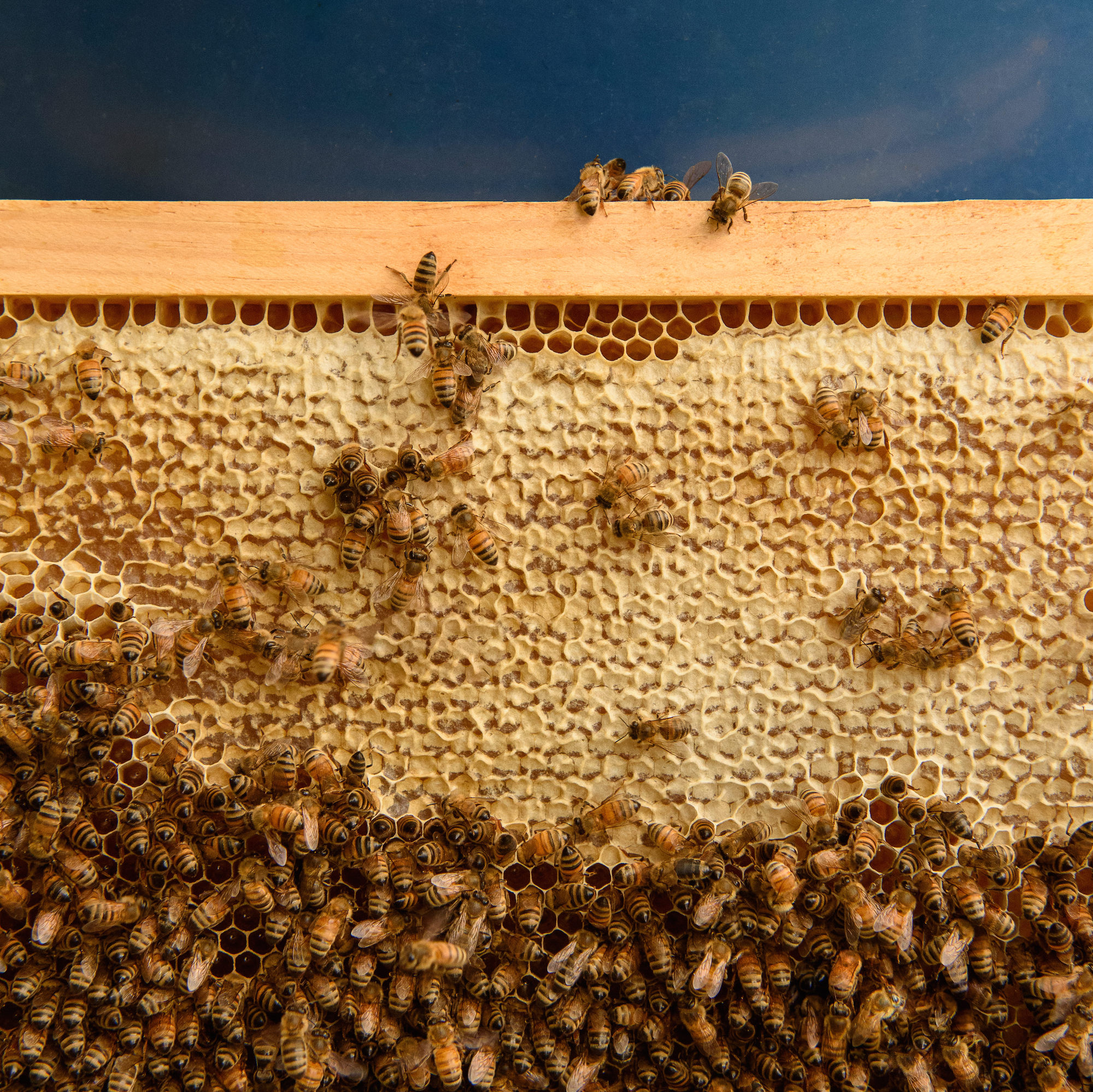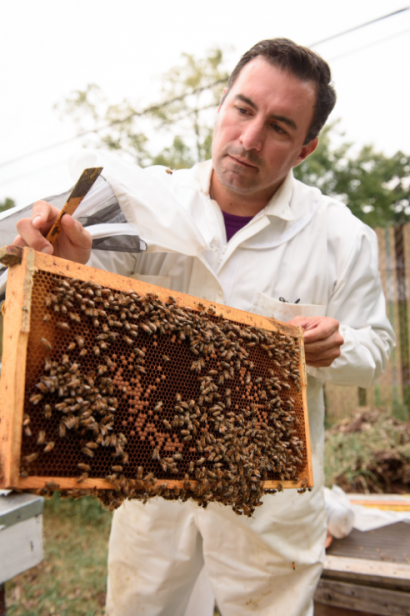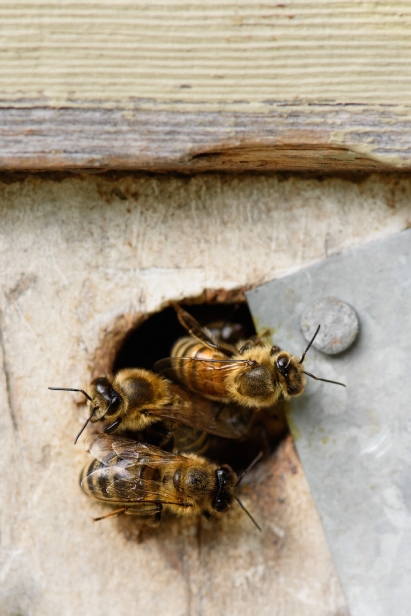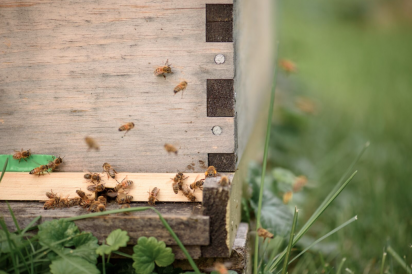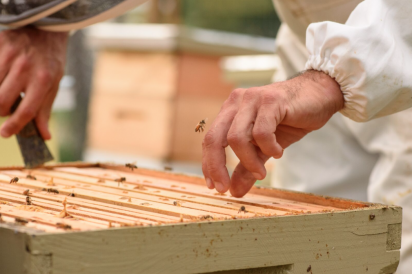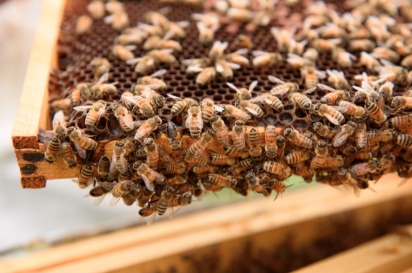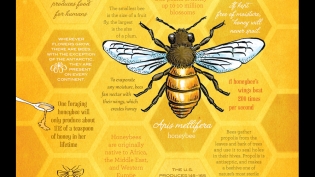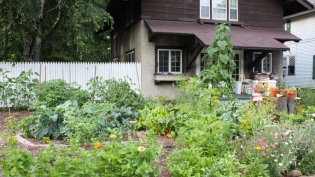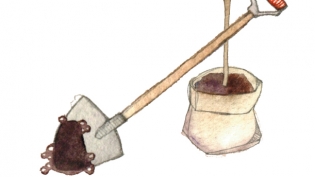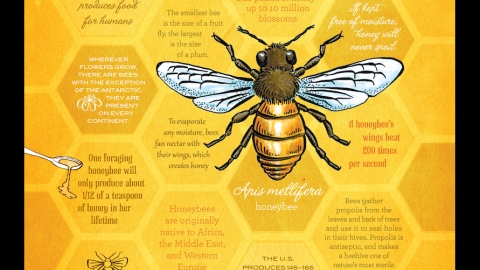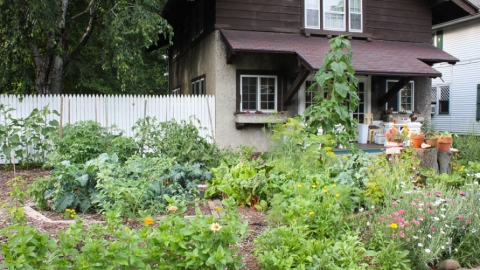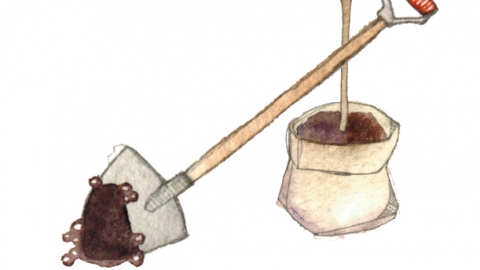Marching to the Beat of a Different Hum
Backyard beekeepers make South Bend a more vibrant city
There’s a strong and steady hum all around us. Even the ground seems to vibrate where I’m standing, just two feet from a three-tiered pastel blue-and-yellow beehive. Roy Saenz squeezes the bellows on his handheld smoker and dispenses targeted puffs of smoke onto the frame he’s about to slide out of the box.
“We’re still here,” he says to the bees moving along the top of the frame. “No worries. Nothing to see here.”
One honeybee lands on the back of my hand and walks a slow circle, abdomen pulsing. I’m staring hard and feeling every tiny step on my skin before it takes off again. Just like Saenz, I was taught to stay away from any critter that might sting me.
“My mom told me, ‘If it stings and flies, run away,’” says Saenz. “But I actually find it very calming working with the bees.”
Saenz pulls out the frame and studies one side, looking for the queen and checking for signs of mites or beetles. Honeybees are everywhere—flying all around us and crawling all over the frame about a foot and a half from Saenz’s nose. He slowly flips the frame over and a bunch of bees dive-bomb his goggles.
Saenz grabs the smoker and starts puffing at the frame again. The smoke masks the bees’ alarm pheromones, allowing Saenz to do the work of splitting the hive. He will locate the queen and put her and a bunch of bees in a new, smaller hive called a "nuc" so the remaining group of bees can raise up a new queen.
Saenz, a financial adviser, adjunct professor and entrepreneur, has kept two to 10 honeybee colonies for about a year and a half in his backyard on the northwest side of South Bend and plans to add hives to two vacant lots he owns nearby. He hopes to eventually maintain up to 200 colonies, grow fruit trees and work with veterans who suffer from post-traumaticstress disorder. As a veteran, Saenz finds beekeeping therapeutic. He also loves honey, finds bees fascinating and wants to contribute to a healthy local and global ecosystem.
Photo 1: Beekeeper Roy Saenz inspects a hive frame that is crawling with honeybees. He’s looking for signs of colony health, including the presence of an active queen, fresh eggs and growing larvae.
Photo 2: Honeybees congregate around a hive entrance. The tiny hairs you see on their bodies help them collect pollen.
A Bee-Friendly City
In the spring of 2013 the South Bend Common Council passed an ordinance allowing city residents, like Saenz, to keep bees with just a few restrictions regarding size and how close hives can be to adjoining properties and sidewalks. Beekeepers must keep hives at least four feet away from property lines and 10 feet from public sidewalks. They must also install a flyway barrier—a fence, wall or hedge of dense vegetation—around the hive and provide a fresh supply of water to prevent bees from congregating around backyard pools.
“There was a lot of anxiety when we passed the ordinance,” says South Bend Mayor Pete Buttigieg. “We were concerned about bees stinging people. We haven’t seen any of those fears come to pass.”
The ordinance was set in motion by electrical engineer Vince Barletto, who became interested in keeping bees after seeing them at the St. Joseph County Fair. Barletto reached out to Councilman Tim Scott when he found that the South Bend city regulations were outdated.
“When South Bend was being developed, they wanted to push farmers away from the city because livestock could be a nuisance, including horses, pigs and bees,” says Barletto, who keeps one hive in his backyard. “Now we are experiencing a real problem with declining bee populations across the world. Though very small, bees are a huge step toward sustainability.”
The ordinance probably didn’t incite a huge influx of hives in the city, but at least one backyard beekeeper on the northwest side of the city was inspired to action when he heard that the ordinance had passed.
“It’s something I had thought about for a long time,” says KC Nieboer, St. Patrick’s Park leisure service supervisor. “Finally, when the ordinance passed, I said, ‘Here’s my opportunity to help the environment and neighborhood gardens.’”
It’s difficult to know how many were similarly inspired because the ordinance does not require beekeepers to obtain a permit. There are at least seven beekeepers with around 48 total honeybee colonies in the city of South Bend; 22 of those colonies are located at South Bend Unity Gardens, a local not-for-profit that brings socioeconomically diverse neighborhoods together at its more than 40 community gardens and offers free classes and summer camps for kids focused on gardening and nutrition. In January 2014, the Unity Gardens presented Mayor Buttigieg with an award naming South Bend a bee-friendly city.
Photo 1: A healthy and active honeybee colony will buzz with activity around the hive entrance. If you look closely, you will see golden sacs of pollen on the hind legs of at least one honeybee.
Photo 2: Beekeeper Roy Saenz inspects hive frames one by one in his backyard on the northwest side of South Bend. You’ll notice he isn’t wearing gloves. Some beekeepers wear thick leather gloves, some wear thin examination gloves and others wear none, all based on comfort and preference.
Honey from the Hood
The diverse vegetation in urban areas may make for more complex and better-tasting honey. The 22 colonies at four Unity Gardens in the city are managed by Tim Ives, local beekeeping legend and owner of honey business Ives Hives. The honey produced there, Honey from the Hood, has brought home awards from the local Michiana Beekeepers Association, the Beekeepers of Indiana and the national American Bee Federation. Honey from the Hood took first place for best honey at the Beekeepers of Indiana conference in 2003 and 2016.
“We started adding beehives to pollinate our gardens,” says Unity Gardens leader Sara Stewart. “A year later we got honey and started winning awards. That really attracted people and we started selling a lot of honey to help sustain our organization.”
The Unity Gardens have become a permanent fixture in the community since it began providing access to fresh, nutritious food in 2008. Anyone can come and pick produce, attend gardening and cooking classes or participate in summer gardening camps, all for free. The largest Unity Garden, LaSalle Square, sits on a seven-acre property smack in the middle of a diverse section of South Bend.
“It has the reputation of being the highest crime rate and the lowest economic status in the entire county,” says Stewart. “We’ve gotten to know them. We take some of the same things that attract kids to gangs—sense of belonging, sense of competency and taking care of your family—and infused it into our garden camp.”
The LaSalle Square Garden is vibrant with life spring, summer and fall: birds calling, people picking sweet peas and lettuce, kids tasting just-picked strawberries and mint for the first time and honeybees busy visiting clover, wild flowers, raspberries and blackberries. Along with grants, farmers market sales and other donations, Honey from the Hood income helps sustain the organization and its three full-time employees.
A Healthier Ecosystem
Bees are a critical part of agriculture and life around the globe. Some estimate that up to one-third of U.S. crops rely on honeybees for pollination, not to mention many native plants that feed wildlife across the nation. During the past 10 years, many millions of beehives have been lost at alarming rates due to colony collapse disorder, a mysterious phenomenon in which a bee colony will disappear, leaving the queen and larvae behind. According to the Bee Informed Partnership, more than 40% of U.S. beehives collapsed from April 2015 to April 2016.
Fingers have been pointed at many possible causes, including disease, climate change, pesticides and habitat loss. Countless people, including Michiana residents, are asking how they can help save the bees.
Jeff Nixa started keeping bees to do his part in fighting colony collapse disorder and to make his backyard ecosystem more vibrant. “That first year with new bees, my yard, flowers, blossoms, fruit trees just exploded with color and more abundance. It was just amazing,” says Nixa, a shamanic practitioner, author and massage therapist. “It’s turned into a real eco-spiritual practice for me.”
Every beekeeper I met started out with the goal to help pollinate their backyard garden, the neighborhood or the whole city. According to Mayor Buttigieg, the call for bees comes out of a growing local interest in sustainability and urban revitalization, and a desire to contribute in a positive way to the national and global issue of colony collapse disorder.
“We live in an urban forest,” says Buttigieg. “Anything that supports the floral vegetation and green life in the city, including promoting a healthy bee population, that’s something we should take every opportunity to support.”
Peace Bees head of operations Steve Lesniak teaches natural beekeeping practices throughout Michiana and is in the process of launching a beekeeping job training program in partnership with Goodwill Industries and Our Lady of the Road for people looking to re-enter the workforce after serving time in prison. Lesniak says urban landscapes like South Bend can offer bees a healthier and more diverse source of nutrition, and exposure to fewer pesticides.
“Research has shown that urban hives sometimes do better than rural hives because there can be more sources of food in the city,” says Lesniak. “Trees, for example: Maples are very common, there’s tulip poplar, people have fruit trees in their backyards. Small gardens: flower gardens and vegetable gardens. Then there are the vacant lots. To a resident, they are seen as a blight, ugly. But to a bee—they produce weeds! Honeybees love dandelions, white Dutch clover—which many consider a weed—and goldenrod.”
Buttigieg agrees that vacant city lots have potential. “As a city that has a number of vacant lots that may remain vacant for quite a few years, we should be looking at all options, including urban agriculture, as a way forward to return this land to productive use.”
Save the Bees
Most new beekeepers start out by ordering bees. It’s not easy to catch a swarm with no experience, and it can be tricky to find a beekeeper willing to help you get started with a proven "nuc," a four- or five-frame hive including a queen. However, hives ordered from Southern states struggle to survive extreme temperatures and other outside factors like mites.
If you are interested in keeping bees, it’s a good idea to start by learning as much as you can. Get connected with local beekeepers through groups like the Michiana Beekeepers Association and attend local beekeeping classes. Take your time and try to find someone willing to help you get your hands on bees that have made it through at least one Indiana winter.
If you’re not interested in keeping bees but want to help local bees thrive, don’t use pesticides or herbicides in your yard and start planting bee-friendly vegetation all over the place. Honeybees love lavender, echinacea, aster, black-eyed Susan, sage, oregano and more.
Michiana Beekeeping Resources
Peace Bees beekeeping classes
574.383.9260
Michiana Beekeepers Association
574.910.0060
Facebook groups:
Where to buy Honey from the Hood
Unity Gardens booth at the South Bend Farmers Market
Purple Porch Co-op, South Bend
Chicory Café, South Bend
Indulgence Pastry Shop & Café, South Bend
Javier’s Bistro, South Bend
Down to Earth, Granger
Related Stories & Recipes
From Yard to 'Yarden'
From rural backyards to urban front yards, local “yardeners” are growing food at home to feed their families, be more self-sufficient, use resources more mindfully and create edible landscapes just as...
Resources for "Growing Your Own"
Get started with your own 'yarden' or kitchen garden!
Putting the Beds to Bed
A guide to tucking your garden in for the winter


